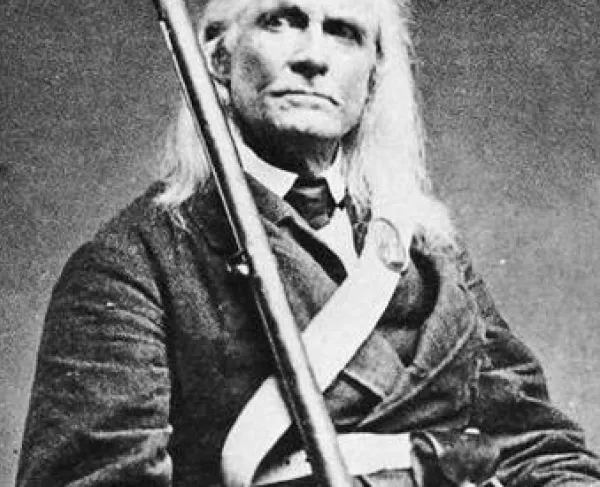Edmund Ruffin

Long mistakenly credited as the man who fired the first shot of the Civil War (that honor goes to Lt. Henry S. Farley), Edmund Ruffin III began his career as an agricultural scientist, not a Southern firebrand. Ruffin was born on January 5, 1794, in Prince William County, Virginia. Raised among the Southern aristocracy, he descended from a long line of Virginia planters, including William Randolph, an early settler of the colony, and Edmund Ruffin I, a member of the Virginia House of Delegates during the Revolutionary War. Ruffin’s upbringing typified that of a Southern aristocrat. He received a private education as a young boy before attending the College of William and Mary and served in the state militia during the War of 1812.
In 1813, Ruffin married Susan Hutchings Travis and moved to a plantation along the James River, which he inherited from his grandfather and namesake. The couple had eleven children together, but few lived to adulthood. Around this time, Ruffin began conducting experiments to rejuvenate depleted soil. Virginia’s soil had suffered from decades of tobacco farming, so much so that it reduced many of the nutrients from the ground. Based on his research, Ruffin promoted crop rotation and recommended using marl, or lime, to reduce soil acidity.
By 1843, Ruffin owned two plantations and over 90 slaves. However, he left daily operations of both estates to overseers while he and his family resided in Petersburg. Likewise, Ruffin became an outspoken supporter of slavery and Southern traditions. He justified enslavement as a form of “stewardship” and argued for secession long before the Civil War. As the country’s sectional hostilities intensified, Ruffin's writings in defense of slavery drew more attention than his agricultural contributions. Some branded him a Fire Eater, while others viewed him as a Southern hero.
In 1859, Ruffin traveled to Charles Town, Virginia, to witness the execution of abolitionist John Brown after his failed revolt at Harper’s Ferry. Wearing a borrowed overcoat and carrying a musket, he joined the Virginia Military Institute corps of cadets, who oversaw the execution. After Brown’s death, Ruffin came to possess several of the pikes used in the Harper’s Ferry raid, which he sent to each of the Southern governors to remind them of the danger and violence that accompanied abolition. The following year, Ruffin continued his crusade to preserve slavery by publishing Anticipations of the Future, to Serve as Lessons for the Present Time, a fictional work in which he predicted Southern victory in an American civil war. Though he incorrectly foresaw William H. Seward as president and the Civil War to begin in 1868, Ruffin did accurately anticipate the war to start with an attack on Fort Sumter in Charleston Harbor.
When Abraham Lincoln won the presidential election of 1860, Edmund Ruffin traveled to South Carolina to promote immediate secession. There, on April 12, 1861, Ruffin took part in the Battle of Fort Sumter as part of the Palmetto Guard. At 4:30 a.m. Captain George S. James ordered Lieutenant Henry S. Farley to fire on Fort Sumter. Lt. Farley pulled the lanyard of the 10-inch mortar. The mortar shell arced across the harbor and exploded over Fort Sumter. This was the signal shot to let all the other batteries in the harbor open fire on Sumter. Thus, Fort Johnson at Fort Sumter fired the first Civil War. Edmund Ruffin of Virginia was the man most often associated with the first shot. The 67-year-old secessionist was posted on nearby Morris Island with the Palmetto Guard. He fired the first shot after this signal, and his was the first shot to hit the brick fort. The following day, Ruffin was among the first to enter the fort after it fell. The Confederacy’s victory at Fort Sumter and Lincoln’s subsequent call for volunteers to put down the rebellion compelled four more states to leave the Union. When he returned home, Ruffin rejoiced at the news of Virginia’s vote to secede.
Edmund Ruffin continued to devote himself to the Confederate war effort as the war progressed. He traveled from one army camp to another, rallying troops, many of whom revered him as a champion of the Southern cause. However, in 1864, the fortunes of war began to turn against the Confederacy. As Union armies neared Petersburg, Ruffin left his home in the city for his son’s plantation in Amelia County, Virginia. Federal and Confederate troops plundered several of Ruffin’s properties during the war. His plantation on Coggin’s Point was the scene of the Beefsteak Raid during the Siege of Petersburg.
By 1865, Ruffin had endured the premature death of his wife and eight of his children. When General Robert E. Lee surrendered the Confederate Army of Northern Virginia at Appomattox Court House, and Ruffin’s health grew increasingly poor, the seventy-one-year-old rebel decided to end his life. On June 18, 1865, Ruffin wrote his final diary entry in which he proclaimed his “unmitigated hatred to Yankee rule.” Then, he wrapped himself in a Confederate flag, placed the muzzle of his rifle in his mouth, and used a stick to discharge the weapon. The gun initially misfired. Ruffin reloaded the weapon and this time it discharged, taking his life. He was buried on his Marlbourne plantation.





